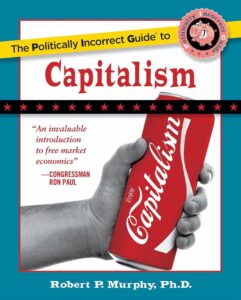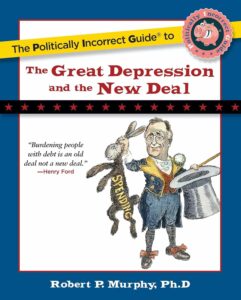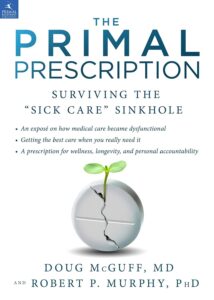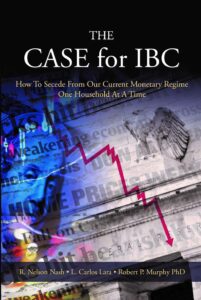The Infamous Counterfactual
In my exchange with two critics on Kudlow’s show–and by the way, I should acknowledge publicly that Kudlow was extremely nice to me, going out of his way to let me talk on two separate occasions since I’m not used to rumbling with the big boys–I was saying that the conventional wisdom regarding the “rescue” of the credit markets is (as usual) exactly backwards. We were told that TARP and the Fed interventions were necessary to prevent the credit markets from seizing up, lest regular-Joe businesses lose the ability to meet payrolls and so forth.
The odd thing about this claim is that the volume of business loans was at all-time high in October 2008 (when TARP kicked in), and has since fallen steadily, down about ten percent through the most recent data point. (Or is it datum point?) See for yourself in the chart below; note that the huge spike shows when Bernanke pumped all the reserves into the financial system.

And for those of you who despise Monday-morning quarterbacking, recall that I was on this in real-time (picking up on the work of Alex Tabarrok).
Of course, Austrian economists are big on “counterfactuals.” This is why we get so much grief from positivists. At Mises University we stress that economic laws are a priori and can’t be tested, just like you don’t take a ruler and compass (not the needle kind) and go “test” the Pythagorean theorem. For example, the Law of Demand doesn’t actually say, “If prices go up, quantity demanded goes down.” Rather it says, “Other things equal, if prices go up…” In other words, it is a counterfactual claim.
Ironically, I explained the primacy of economic logic, as opposed to simple historical data crunching, in a Mises Daily article from 2004 where my target was a fellow with the initials LK. (And no, it wasn’t Lenny Kravitz.) So I am perfectly happy with counterfactual claims that apparently fly in the face of what “the data” tell us.
However, regarding the Treasury and Fed interventions and the credit markets, I have a perfectly good theory to explain what happened: Bernanke and Paulson started guaranteeing everything in sight, and the conventional wisdom became, “It was a mistake to let Lehman fail.” So of course the spreads on certain types of debt would shrink back to “normal” levels; there’s no reason to prefer Treasurys over Goldman debt if you think Goldman is backed up by the feds.
At the same time, banks would stop advancing new loans to medium- and small businesses, who weren’t ever going to get bailed out, because the economy was still awful and most important because Bernanke literally began paying them NOT TO make new loans.
Economists are big on saying incentives matter. So why should we be surprised that when Bernanke injected hundreds of billions in new reserves, and then began paying interest to banks for keeping those reserves parked at the Fed, that the amount of loans to the private sector started dropping?
My Investment In Deeply-Out-of-the-Money Callahan Calls Pays Off
No joke, whenever Gene Callahan rants against the people on the front lines in the intellectual battle against the Leviathan State, I get emails to the effect of, “What’s up with your buddy?” “Why do you associate with that guy?” “Should I keep recommending Economics for Real People?”
I know not what course others may take, but as for me, give me more of the guy who writes stuff like this:
You may have seen the status going around Facebook that reads, “[JOHN DOE] thinks that no one should die because they cannot afford health care, and no one should go broke because they get sick.” (This is meant to be an argument for Obama’s health care package, I surmise.)
Well, I posted as my status another blurb, not original to me, that says, “No one should be frozen in carbonite, or be slowly digested for a thousand years in the bowels of a sarlaac, just because they couldn’t pay Jabba the Hut what they owe him.”
Normally the only blog posts that make me laugh out loud are my own. The above was a pleasant break.
Quick Thoughts on My Trip To Seattle
So I went to dinner and now I’m back in the hotel room, where it’s 8 pm local time but 10pm physiologically. I could feel myself starting to crash when I was walking back to the hotel, and I knew I wanted to get some work done tonight. What to do?
Some people would get chocolate, some would get caffeine, some might hit the gym for some quick cardio. Me, I popped into the Barnes & Noble to sign my books. That always makes me feel special and gives me the strength to continue.
Anyway, here are some quick thoughts:
* Oh my gosh, I didn’t realize how long the Detroit-Seattle flight would be. Normally I would just nap, but I was in the middle seat, somebody in my vicinity kept releasing greenhouse gases from his rear, and I had slept on the previous flight so it really wasn’t in me. I had foolishly neglected to bring any reading material, and when the pilot said we were 3 hours away, I considered gouging out my eyeballs. Instead, I actually read the in-flight magazine’s 12-page story on how great St. Paul / Minneapolis are for business. Then I solved the brain teasers (except the ones that would take two seconds with algebra; I know I could do it, I just didn’t have a pen handy). Then I read the descriptions of this season’s new TV shows, even though I don’t have a TV. Then I stared at the maps of Delta flight routes for a good 15 minutes. (Did you know Salt Lake City is a much bigger hub than Chicago? OK that’s not shocking, but did you know Memphis is a much bigger hub than Chicago?) If it weren’t for that magazine, I probably would have solved the Riemann hypothesis.
* A guy eight seats in front of me had the exact same shirt on that I did. (Well, not the exact same shirt–that would have been size XXXXXXL. You get what I mean.) Isn’t it odd how rarely that happens? That’s probably the second time in my life that I’ve seen a guy with literally the same shirt that I had on at the time. And it’s certainly not because I have such cutting edge fashion sense. Speaking of which, when movie stars go to the Academy Awards etc., do their publicists or whoever coordinate beforehand, to make sure nobody is coincidentally too similar to each other? That would be horrible in the gossip world.
* In the Detroit airport there were canine units all over the place, letting the dogs sniff everyone’s luggage. What annoyed me was everyone was like, “Awww, what a cute puppy,” instead of, “Umm, I think your goosesteps need to be a little higher.” Haven’t these travelers read Animal Farm? These were not cuddly doggies. I’m so glad I took that ribeye out of my laptop bag last night.
* When you’re walking down a hotel hallway and you see a room service tray on the floor with fries that look fairly new, are you tempted to grab any? Oh, me neither, that’s gross! Sick man! I was just asking.
* Seattle was gorgeous today; it was 83 and not a cloud in the sky when I got to the hotel (around 5pm local). I kept waiting for someone to say, “Oh, you were going to Seattle Washington? You better get back to the airport; this is Seattle California.”
* Scott Sumner’s blog is simply perfect for reading on a Blackberry while you’re at a restaurant by yourself. His posts are too long for me to sit down and read when I’m at a computer and could actually be doing something productive, but if I’m just sitting somewhere and can only surf, then his posts are simply superb. If I could clone myself, I would devote Bob Murphy #8 to making blog posts as sweeping as Scott’s. For example, by the time I got my check tonight, I had catalogued 5 statements in this post that I thought were astoundingly wrong. And yet, Scott makes error seem so easy. How does he do it? Practice practice practice I guess.
Correction
I just want to bring to everyone’s attention that in a recent post I incorrectly implied that Walter Block was drinking alcohol at a party when he was debating fractional reserve banking with Bob Lawson. Walter corrected me and said he doesn’t drink alcohol.
What I meant was, between Bob Lawson and Walter, they had had enough alcohol to intoxicate two average men.
Headed to Seattle
I am the hardest working ancap in show business. After being told that Down Is Up, I’m off to another Mises Circle, this one in Seattle.
I have a backlog of blogging to do; I hope to catch up in the hotel. So much economic ignorance; so little time.
Speaking of which, in today’s Mises Daily I take on that NYT article praising fiat money for allowing the Union to wage the Civil War. (Remember Carlin? “Can a war really be civil? ‘Excuse me sir, I’m going to shoot you now!'”)
(All joking aside, in the linked article there is a chart showing the loan information I was referring to on Kudlow’s show, when the other guy told me we all knew what the alternate universe looked like.)
Murphy on Kudlow Discussing Geithner
I hadn’t put two and two together… It wasn’t until I was sitting in the chair with the mic in my ear that I realized I was going to be on Kudlow’s show. (It was probably all for the best, since the adrenaline would have been pumping even more had I known for two hours beforehand.) Anyway, I walked out of the studio feeling pretty good about the points I made. I was disappointed when I discovered I had said, “It’s glad to be here…” right out of the gate, but hey I just wanted to make sure you were listening.
Thanks so much to “Minnesota Chris” for posting this. It was actually ready by the time I got back to my computer and checked my email. These Austrian computer geeks are taking over!
UPDATE: I forgot to mention–and I’m not making this up–the camera man had to adjust the camera up a few notches when we were getting situated. The previous interviewee had been a lineman for the Tennessee Titans and apparently I was taller from the butt up. Yeah, what’s up.
UPDATE 2: BTW, in case anyone actually wants to hear what others had to say, here is the full Kudlow segment:
Murphy on Panel to Discuss Geithner Town Hall
OK kids, someone needs to set your TiVo or whatever wacky new gadgets you use nowadays, because I just found out I’m going to be on CNBC tonight on a panel discussion following Geithner’s town hall. So if I understand correctly, Geithner’s thing starts at 7pm EST and then our panel discussion begins at 8pm EST. It would really be cool if someone could capture this for YouTube.
Geithner Says It’s Time to De-Fascize
Treasury Secretary Timothy Geithner said Thursday the economy has regained enough strength to allow a shift in the government’s strategy from rescue to preparing for future growth.
Appearing before the Congressional Oversight Panel for the $700-billion Troubled Asset Relief Program, Geithner said the economy was in far better shape now than a year ago when it was “on the verge of collapse,” though it still had problems.
…
“As we enter this new phase, we must begin winding down some of the extraordinary support we put in place for the financial system,” Geithner said.
He said banks that received capital injections in the form of taxpayer-provided funds have repaid more than $70 billion, reducing the government’s total investment to $180 billion.
“We now estimate that banks will repay another $50 billion over the next 12 to 18 months,” he added.
Another senior Treasury official told reporters earlier that Treasury will allow its money market mutual fund guarantee program to expire on Sept. 18.
The backstop program was created a year ago to prevent panic withdrawals of $3.4 trillion in savings after a key fund “broke the buck” when its net asset value per share fell below $1.
The program took in $1.2 billion in fees from funds, but has not had any payouts.
Geithner boasted that the economy now was “back from the brink” of a free fall that it was in when the Obama administration took office in January, though he cautioned recovery will be gradual at best.
Still, he cited several signs of progress, including the fact that the government no longer feels it needs a contingency in the budget for another $750 billion in stabilization funds.
“Today, we believe that money is unlikely to be necessary and we have removed it from budget provisions, lowering this year’s deficit,” Geithner said.
Treasury does intend to press ahead with so-called public-private investment funds to buy toxic assets.
The senior Treasury official predicted that the first purchases should occur by early October.
The official said there was a “great deal of interest” in purchasing toxic assets among investors and money managers running the funds, but the appetite among banks to sell their toxic assets has been less than anticipated.
“We thought it would be necessary for banks to sell some of these assets in order to attract private capital.
It turned out that they were able to raise the capital without selling the assets,” the official said.
Geithner said that by providing support for U.S. automakers, the government avoided substantial job losses and that a specially assembled Auto Task Force had avoided intervening in day-to-day decisions by management of General Motors Corp and Chrysler Corp.
“Such intervention could seriously undermine the companies’ long-term viability and, consequently, their ability to repay the taxpayer for its investment,” Geithner said.
He cited a litany of problems still facing the economy, including “unacceptably high” unemployment, a shaky mortgage market outside those covered by mortgage finance sources Fannie Mae and Freddie Mac, strained financing for commercial real estate enterprises and tight credit for small business.
Given those conditions, “it is realistic to assume recovery will be gradual, with more than the usual ups and downs,” Geithner warned.
I’ve put some of the predictions or promises in bold above. Let’s check in periodically to see how they hold up.







Recent Comments